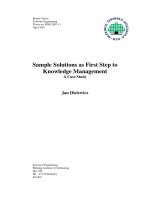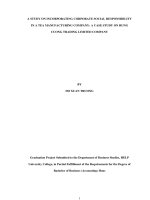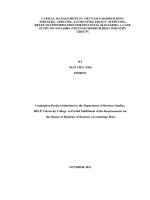Digital Sound Recorder: A case study on designing embedded systems using the UML notation.
Bạn đang xem bản rút gọn của tài liệu. Xem và tải ngay bản đầy đủ của tài liệu tại đây (135.21 KB, 37 trang )
Digital Sound Recorder: A case
study on designing embedded
systems using the UML notation.
Ivan Porres Paltor
Åbo Akademi University, Department of Computer Science,
Lemminkäisenkatu 14, FIN-20520 Turku, Finland
email:
Johan Lilius
Åbo Akademi University, Department of Computer Science,
Lemminkäisenkatu 14, FIN-20520 Turku, Finland
email:
Turku Centre for Computer Science
TUCS Technical Report No 234
January 1999
ISBN 952-12-0367-6
ISSN 1239-1891
Abstract
This document is an example of the object-oriented analysis and design of
an embedded system using the Unified Modelling Language (UML). The
analysed system is a digital sound recorder, or Dictaphone. The design has
been implemented using an embedded processor and the C++ programming
language.
Keywords
: object-oriented design, UML, embedded systems.
TUCS Research Group
Programming Methodology Research Group
1
1
Introduction
The Unified Modelling Language [BJR1, BJR2], provides a standardised notation to
express object-oriented software analysis and design [CY90, MO92, SS95]. UML
diagrams are able to model complex software systems including real-time embedded
systems.
However, UML is not a software process. UML does not specify the different stages of
the development of a software project. The UML standard specifies a notation for
several different diagrams, but it does not describe how to create and apply each
diagram. [Dou98] presents a methodology for building embedded systems using the
UML notation and object-oriented analysis and design techniques.
This document describes the object-oriented design and implementation of a digital
sound recorder, or Dictaphone, using the UML notation and the method described by
Douglass.
There are several digital sound recorders commercially available in the market. The
model described here has been designed following the specifications of a commercial
product from a well know manufacturer. These requirements are described in the second
section of this document.
The third section discusses the object model of the system and presents the main class
diagram. The fourth section continues the object-oriented analysis but focusing in th
internal behaviour of each object.
The fifth section deals with the architectural design. We show the hardware architectur
of the sound recorder and the concurrency model, where we assign each object to an
execution thread.
The design continues defining the collaborations between the different objects. This is
done in section number six, where design patterns [GHJV95] are used to glue together
the classes defined in the analysis phase. The most specific design issues are discussed
in the section number seven.
Finally, The eighth section discusses the implementation. We have implemented th
software in the C++ programming language and built the hardware platform to run the
code using a 32 bits RISC embedded processor.
1.
2.
2
Requirements Analysis
A digital sound recorder is a consumer electronic appliance designed to record and play
back speech. The messages are recorded using a built-in microphone and they are stored
in a digital memory. The user can quickly play back any message at any moment trough
a speaker placed in the front of the device. It should be small, light, easy to use, and
battery operated.
Figure 2.1 shows what our sound recorder could look like. It is a hand held unit with
flat display and fairly large buttons.
2
NoYes
Figure 2.1: External appearance
The main features of the product that we are going to consider in our design are:
•
Capacity for ten different messages. The length of each message is limited by the
available memory.
•
Easy to use with on screen menus.
•
Direct access to any message.
•
Alarm clock with year-2000-ready calendar. The user can set a daily alarm. The
alarm beeps until the user presses a key, or after 60 seconds.
•
Full Function LCD Display. The current date and time is always shown in the
display. The display also shows clear directions about how to use it and what it is doing.
•
Battery-level indicator. The system beeps when the battery is low.
•
Stand-by mode. It economises the battery power. The system switches off th
peripherals when they are not in use. The normal operation is resumed when the user
presses a key.
•
Good sound quality. Sound is processed at 6Khz using eight bits per sample.
2.1
External Events
An embedded system is constantly interacting with its environment. In this first stage of
the analysis, we can consider our system as a black box reacting to the requests and
messages from the environment. The environment is composed of several agents. Each
agent interacts with our system with a different purpose and it exchanges a different set
of messages.
Context-Level Diagram
Figure 2.2 shows all the agents that interact with our system. We have identified thre
agents: the user, the battery and the time. It also shows the interfaces, sensors and
actuators that allow our system and the agents to exchange messages. These messages
can be requests from the agents to the system, or responses and services from the
system to the agents. The sensors for the messages from the user are the microphone
and the buttons. The actuators for the user agent are the speaker and the display. The
battery level meter senses the state of the battery.
3
Digital Sound Recorder
User
Sensors/Actuators
+Buttons
+Microphone
+Screen
+Speaker
+Battery Level Meter
Interfaces
-Analog To Digital
-Digital To Analog
-Digitral to Digital
System
Battery
Power
Record
message, set
alarm, set time
Play message,
beep alarm, show
time
Time
next second
Figure 2.2: Context-Level diagram
The Time agent sends a message to our system whenever the time passes. It represents
the source of messages like “next second” or “next hour”. In the real implementation, a
hardware timer measures the pass of the time.
Events
An event is an important message from the environment. A real-time reactive system
has to react to the external events in a bounded time. The following table shows all the
external events that can occur in our system. The direction of an event can be “In”, from
the environment to the system, or “Out”, from the system towards the environment. The
arrival pattern (A) can be Periodic, if the event occurs on a fixed time basis, or
Episodic, if its arrival time is random. The Response time sets an upper bound for the
system response actions. The system will behave incorrectly if it does not react within
the response time.
Event System Response Direction A Resp.
1 A second passes
a.
Update internal clock
b.
Check alarm
c.
Update clock display,
d.
Update task progress display.
In P 0.5 s
2 A sample period passes a. Play or record next sample In P ½ period
3 User presses a command button
a.
Show task progress display
b.
Start recording or playing a
message
In E 0.5 s
4 User presses the “stop” button a. Current task is stopped
b. Update display
In E 0.5 s
5 Low battery alarm a. Warn the user and stop current
task
In E 1 s.
6 Enter stand-by mode a. Switch off the display In E 1 s.
7 Wake up, user presses a button
while in stand-by mode.
a. Leave stand-by mode, power up
display, etc.
In E 1 s.
4
User
Playback message
Record a message
Set alarm time
Watch time
Digital Sound Recorder
Set clock time
Delete message
Figure 2.3: Use Case diagram
2.2
Use Cases
Use cases describe the functionality of the system from the user’s point of view. The
user may be a person or another machine. Each use case is a different way to use the
system and the completion of each use case produces a different result. In our system
there are six different use cases, represented in the Figure 2.3.
Record a message
The user selects a message slot from the message directory and presses the ‘record’
button. If the message slot already stores a message, it is deleted. The system starts
recording the sound from the microphone until the user presses the ‘stop’ button, or the
memory is exhausted.
Playback a message
The user selects a recorded message slot and then presses the ‘play’ button. If th
message slot contains a recorded message then it is played trough the speaker until its
end or until the user presses the stop button.
Delete a message
The user selects a used message slot and then presses the ‘delete’ button. The message
is permanently deleted from the memory and its memory space is recycled.
Set the alarm time
The user can switch on and off the alarm and set the time when the alarm will sound.
This is done by selecting the different options of the alarm menu.
5
Set the clock time
The user can set the clock time and adjust it to the current time zone.
Watch the time
The system constantly shows the current time and date on the display. The user just
looks at it.
2.3
Scenarios
The scenarios should describe the interaction between the active external actors (the
user, the battery and the time) with the system. Even if the role of each actor is usually
clear, it can be difficult to study all the possible interactions between all the actors and
the system. E.g., we have to study what happens when the battery goes low while th
system is playing a message, or what to do if the alarm sounds while the system is
recording a message. Figure 2.4 shows an scenario for the Play Message use case.
<< actor >>
User
: System :Speaker
1: Play Message
2: Start playing sound
{0.5 s.}
3: Display Progress Indicator
4: Next Second
5: Display Clock
{ 0.5 s. }
6: Display Progress Indicator
7: Stop
8: Stop playing sound
{0.5 s.}
Figure 2.4: Playing message scenario
Figure 2.5 shows what should happen when the alarm sounds while the user wants to
play a message. We have decided to give priority to the alarm sound.
6
<< actor >>
User
: System :Speaker
1: Play Message
3: Display Progress Indicator
4: Next Second
5: Display Clock
6: Display Progress Indicator
12: Next Second
13: Display Cock
2: Start playing sound
7: Alarm!
8: Start playing alarm
9: Display Alarm Indicator
10: Stop
11: Stop playing alarm sound
{ 0.5 s}
Figure 2.5: Alarm while playing scenario
The system can switch on and off the screen backlight, the microphone and the speaker.
These elements use a considerable amount of battery power. By switching them off the
system saves energy and increases the battery life.
The battery can also warn the system when it is almost out of energy. Then the system
should switch off all the peripherals and enter the stand-by mode. When the user
charges the battery, the system will leave the stand-by mode. While the system is in
stand-by mode, the messages are still kept in the memory.
Figure 2.6 shows a scenario where the system enters stand-by mode, then it is woken up
by the alarm clock. After another battery warning, it enters again stand-by mode.
7
: System :Speaker: Display: Battery
1: Next second
2: Next Second
3: Switch off display
4: Switch off amplifier
5: Next second
6: Alarm !
7: Switch on display
8: Switch on amplifier
9: Start playing alarm sound
10: Next second
11: No Power!
12: Stop playing alarm sound
13: Switch off amplifier
14: Switch off display
After some minutes
without any activity
Figure 2.6: Entering and exiting stand-by mode scenario
3.
8
3
Analysis: Object structure
After the requirement analysis, [SS95] proposes the Domain Analysis phase. In this
phase, we should analyse the requirements and present a class diagram as a general
solution for the problem. The domain diagram shows the main classes of the system and
their relations, but it omits their interface.
The first step in building the class diagram is identifying the objects involved in it.
3.1
Identifying objects
Active Objects
Message Player & Recorder
A “digital tape”.
Buttons, Screen
The user can press the buttons. The screen shows a menu
and indications to the user.
Alarm Clock
It shows the time and it can wake up the user
Services
Battery level sensor
Measures the remaining battery power level
Analogue to digital converter
The interface between the microphone and the processor
Digital to analogue converter
The interface between the processor and the microphone
Screen controller
Generates the image on the LCD screen
Real-World Items
Date
Time
Speech, Sound
Physical Devices
Microphone, Speaker
Battery
Keyboard, Display
Key Concepts
Speech, Sampling, Sound sample
We must study how a discrete digital system can capture
and process an analogue and continuos sound signal.
Sound message
Persistent objects
Collection of recorded messages
The contents of the digital tape
Current Time, Date
Alarm Time
When to warn or wake up the user
Transactions
Message
Visual elements
Menu, Menu option, Menu selection
Clock, Alarm on/off indicator
Calendar
Status bar, help line, Task progress indicator
Play , Record, Stop, Yes, No, Up, Down, Left, Right Buttons
The user interacts with the system by pressing the buttons.
There are nine different buttons
9
10:23:45 10 August 1998
08:00
Message Menu:
Recorded at 09:23 10.08.1998
xRecorded at 12:45 05.07.1998x
Empty message
Empty message
Empty message
Empty message
Empty message
Stop. Press
to play message.
Figure 3.1: User Interface
The visual elements of the user interface are shown in the Figure 3.1. The interaction
with the user is menu-driven and the display always shows the current menu. The top
line shows the current time, date and the alarm time. At the bottom, there is a short help
message for the user.
3.2
Building the class diagrams
The Sound Recorder Class Diagram
The user interacts with the system through the display and the keyboard. These are
somehow passive objects, so we decide to add a user interface object that manages the
interaction with the user. The User Interface class relies on the Audio Controller to
perform the tasks. The Audio Controller is the core of the system and it executes the
tasks suggested by the user interface. The audio controller uses the Audio Input and
Audio Output classes to produce the sounds. These classes are related with a
microphone and speaker hardware wrapper [AKZ96]
Display
Keyboard
Battery
AlarmClock
10
Message
Microphone
UserInterface
1
MessageMemory
10
AudioInput
AudioController
1
Speaker
AudioOutput
Figure 3.2: Sound Recorder class diagram
The messages are stored in the message memory. This class keeps a directory with th
recorded messages, allocates spaces for the new messages, and deletes the old ones.
10
The Alarm Clock updates the internal clock and checks when to sound the alarm. In this
case, it notifies the event to the User interface, so the User interface can show an
indication on the display and play an alarm sound with the help of the Audio Controller.
The Battery object periodically measures the battery power level. When the battery goes
low then it reports the event to the User Interface.
Figure 3.2 represents graphically the main classes of the digital sound recorder. The
class diagrams provide a general overview of the whole system by abstracting from the
details of each class. We have divided the class diagram into five different subsystems:
the alarm clock, the battery, the user interface, the memory and the audio subsystem.
This division is represented in Figure 3.3. The following sections study and develop
each subsystem a bit further.
<<subsystem>>
Audio
<<subsystem>>
User Interface
<<subsystem>>
Memory
<<subsystem>>
Alarm Clock
<<subsystem>>
Battery
Figure 3.3: Subsystems in the sound recorder
The Audio Subsystem Class Diagram
Each message is composed of several audio blocks and each audio block if composed of
many sound samples. The Audio subsystem always records or plays a complete audio
block.
The Audio Input and Audio Output classes have real-time requirements. The Timer
class provides accurate timing for the Audio Input and Output classes. The timer class is
a wrapper for a hardware timer.
The Microphone class is a hardware wrapper for the physical microphone. A
Microphone class can record one sound sample. The Speaker class is able to play back
sound sample through the hardware speaker.
11
CompressedAudioBlock
Speaker
playSample( )
Timer
Microphone
getSample( )
AudioOutput
playCompressedAudioBlock( )
playAudioBlock( )
selectOutputFilter( )
AudioInput
recordCompressedAudioBlock( )
selectInputFilter( )
Synthesiser
buildAudioBlock( )
playNote( )
playChord( )
silence( )
AudioController
playMessage( )
recordMessage( )
deleteMessage( )
playAlarm( )
stop( )
Message
getAudioBlock( )
appendAudioBlock( )
getHeader( )
setHeader( )
0..*
AudioBlock
getSample( )
addSample( )
0..*
Figure 3.4: Audio subsystem class diagram
Why do we need three different classes to play a message? Playing or recording a
message is a complex task that requires a precise timing and interaction with the
hardware. We also believe that by splitting the representation of the messages from their
process we increase the flexibility of the design. This design can be easily extended to
stereo messages with two channels of audio blocks or pipelined compression, where the
sound is compressed while it is recorded.
0..*
*
*
Message
AudioController
plays
AudioBlock
0..*
is a sequence of
AudioOutput
plays
SoundSample
*
is a sequence of
Speaker
plays
Figure 3.5: Internal representation of sound messages
Figure 3.5 shows the decomposition of a message into audio blocks and sound samples.
It also shows what class is responsible to play each element.
Granularity Play Record
Sound sample
1/6000
th
of second
Speaker
.playSample()
Microphone.
.recordSample()
AudioBlock
2000 samples, 1/3
th
of second
AudioOutput
.playAudioBlock()
AudioInput
.recordAudioBlock()
Message (variable length)
E.g. 60 AudioBlocks, 20 s.
AudioController
.playMessage
AudioController
.recordMessage()
12
Figure 3.6 shows the messages exchanged in order to play a message. This diagram has
been simplified to improve its readability. Actually, an AudioOutput object will invoke
the playSample method 2000 times per audio block.
: AudioController : Message : AudioOutput : Speaker : UserInterface
2: getAudioBlock ( )
3: playCompressedAudioBlock ( )
4: playSample ( )
5: playSample ( )
6: playSample ( )
1: playMessage ( )
7: getAudioBlock ( )
8: playCompressedAudioBlock ( )
9: playSample ( )
10: playSample ( )
11: playSample ( )
Figure 3.6: Play message sequence diagram
The Message Memory Subsystem Class Diagram
The message memory class manages the storage space of the sound recorder, it keeps a
directory of recorded messages and it allocates space for new messages. The class
diagram for the memory subsystem is shown in Figure 3.7
The User Interface uses the Message Memory for obtaining the list of recorded
messages, but it does not modify it. The Audio Controller is the only class that uses the
modifiers of the Message Memory. If the User Interface wants to delete a message,
instead of accessing directly to the Message Memory object, it uses the deleteMessage
method of the Audio Controller. This mechanism prevents the User Interface from
deleting a message while the Audio Controller is playing or recording it. Figure 3.8
represents this scenario.









